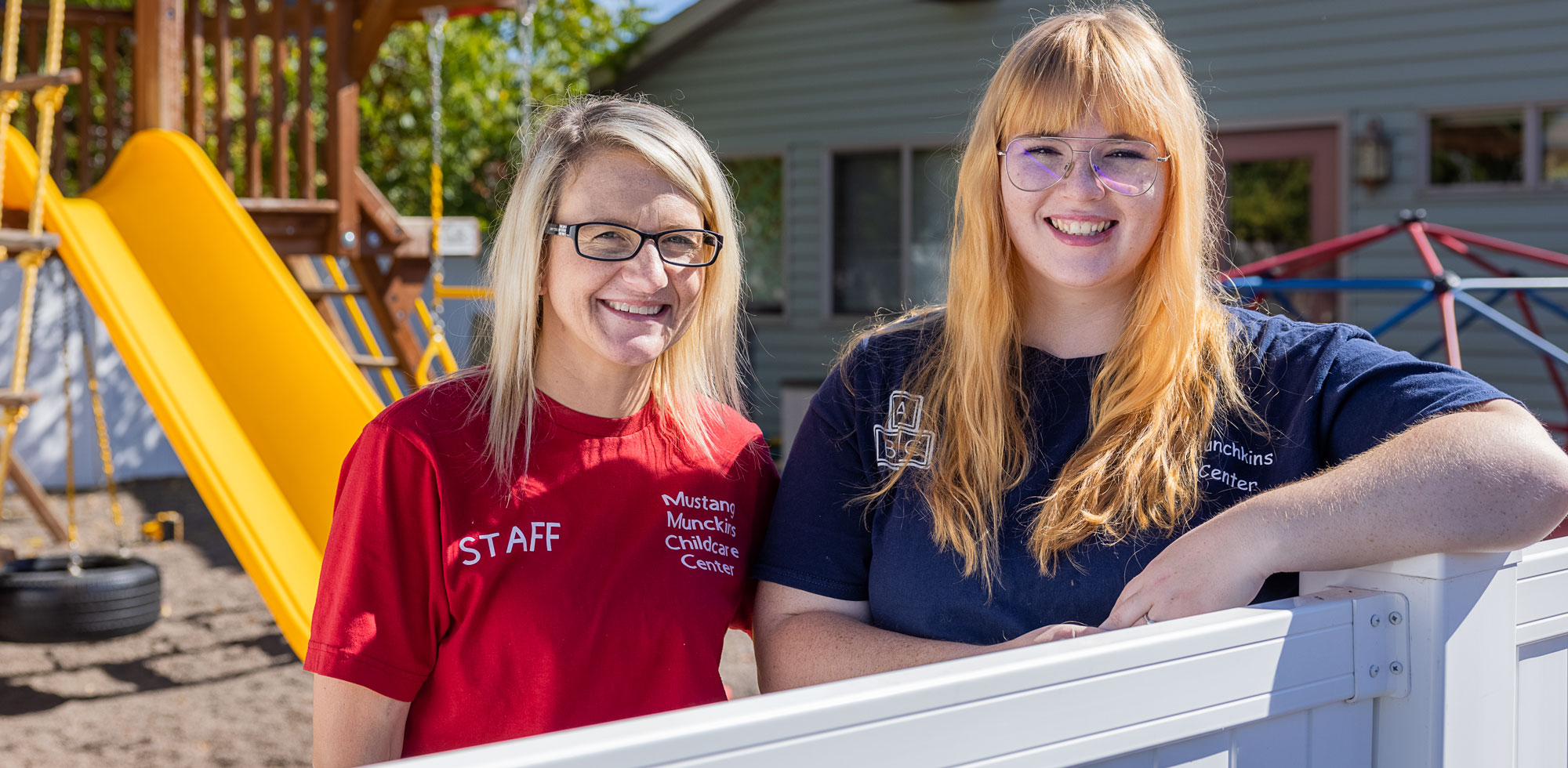
Help Wanted: Child Care Providers
Area colleges offer low- to no-cost accelerated early childhood certificates
By Lisa Meyers McClintick | Photography by John Linn
Rachel Thompson was pregnant with her second child when the pandemic hit and her childcare provider—who suddenly had her school-aged kids at home—decided to close. That left Thompson and her husband, Jesse, on an urgent hunt for two childcare openings as her September 2020 due date neared.
“It’s very difficult to find the infant spots in particular,” the Sauk Rapids resident said. The couple criss-crossed their close-to-home area, from Foley to St. Augusta, and went through three providers during an 18-month stretch. “It was near impossible, even when looking at child care centers,” which typically have more capacity than home-based providers.
If her St. Cloud-based job hadn’t allowed work-from-home flexibility, or if she hadn’t had relatives to help when childcare operations closed due to COVID exposures, she or her husband would have had to quit work to take care of their daughters.
Mande Hatten is the owner of Merry Moose Child Care and Preschool in Richmond and Rockville and a recipient of an Initiative Foundation emergency child care grant in the early days of the pandemic. She said demand is so high that her available child care slots would be booked through 2023 if she weren’t expanding her Richmond location. She and her staff will be able to add 80 more children to their current roster of 129 by the end of the year.
Expansions and new providers, though, aren’t keeping pace with an estimated 4,000 Minnesota child care slots that have been lost—mostly in Greater Minnesota—between late 2019 and late 2020, according to The Center for Rural Policy and Development.
The pandemic piled on to what was already a steady decline in providers as child care evolved from traditional babysitting to more structured early childhood education. The COVID-19 outbreak added new rules, greater responsibility, increased risk and even some resentment as parents or providers—or both—were left without a reliable income when COVID exposure forced quarantines.
“The region is so desperate for child care providers that there’s a bottleneck for anyone returning to work,” said Don Hickman, the Initiative Foundation’s vice president for community and workforce development. “An estimated 15,000 to 17,000 more child care spaces are needed in Central Minnesota alone.”
Fast-Tracking Child Care Certification
Nonprofit organizations, including the Initiative Foundation, along with regional colleges, are working together to find ways to increase interest in the child care profession. One solution is to fast-track early childhood certification with new online classes that can be completed in up to six months. With the current low wages for child care providers top-of-mind, some colleges have waived tuition and book fees for successful graduates.
“We took away the barriers for coming back to school,” said Annette Weaver, education coordinator for Child Care Aware based at Pine Technical and Community College (PTCC) in Pine City. With funding from First Children’s Finance and a $10,000 grant from the Initiative Foundation, the college was able to quickly pull together an accelerated early childhood certificate program that began last spring and wrapped up this summer with 23 graduates.
It’s an effort that’s improving the quality of the region’s child care and makes it a more rewarding career. The program caught the attention of administrators at St. Cloud Technical and Community College (SCTCC), which launched a three-month accelerated certification with funding help from the Initiative Foundation and United Way of Central Minnesota. Central Lakes College in Brainerd also has received support and will join the fast-track certification effort in January 2022.
Expanding the region’s child care options is complex since the business model is largely parent-funded, said Shanda Davis, dean of business, information technology and online learning at SCTCC. “There’s no one organization that’s going to solve this.”
Parents can’t get back to work without child care, and increasingly competitive retail, food service and manufacturing wages make it hard for child care centers to retain employees.

Education Barriers Removed
Like many full-time child care aides or assistants, Sarah Schmitz, a 2019 Sartell High School graduate, didn’t have the funds or the time to attend in-person college classes that would advance her early childhood career and potentially earn more money at Mustang Munchkins Daycare in Mora.
She could, though, manage the accelerated program at PTCC. The college offered online classes two nights a week and shipped books to students, along with laptops and internet hot-spot devices for students in more remote areas.
Schmitz has been able to move up from being an aide to a teacher’s assistant and was in the process of getting a raise.
“It was extremely difficult for me to juggle the classes and my full-time job,” she said, often requiring her to do homework until bedtime. “But once I was done, I was very happy I did it and don’t regret anything.”
Susan Moravec, a 49-year-old mother of four, has run her home-based Love and Learn Family Child Care in Wyoming, Minn., since she was 22. She’s had her Child Care Aware rating—a designation that a Minnesota child care business has scored high on multiple measures of quality—for about three years. She decided to enroll in the certification program to jumpstart her longtime desire to pursue an early childhood degree. The accelerated early childhood certification programs at PTCC and SCTCC are designed as a building block for a one-year, two-year or four-year degree.
Moravec said going through the PTCC program helped her better connect with and teach the children in her care, up to a dozen of them ranging in age from six weeks to 12 years old. She and Schmitz also enjoyed the unexpected camaraderie from their virtual classmates, swapping tips for teaching letters and numbers, dealing with challenging behaviors, and setting up the best learning environments to get kids academically and emotionally ready for school.
“There are just so many ideas we get from each other,” Moravec said.
Better Skills Help COVID Kids
Hatten was an in-home family child care provider in the St. Cloud area for 18 years before getting her early childhood degree and opening her first child care center in Richmond. She’s excited to have eight of her 39 staffers currently in the second half of SCTCC’s accelerated early childhood certification program.
The program began mid-summer and was expected to wrap up with 18 graduates. Planning for a summer 2022 program is under way. For Hatten, she could see results immediately as her staff learned more about early childhood education, such as positive behavior systems and how to be less reactive to challenging kids.
“They look at things differently and try to figure out the child behind the behavior,” she said. That’s especially important right now as they’re seeing the impact of pandemic isolation with toddlers who haven’t been in many social settings, had the chance to be out in the community or to practice transitions between different settings.
At PTCC, a second group of participants began the accelerated certification program in September, and there’s a waiting list for the spring class.
In the more sparsely populated areas of Central Minnesota, program leaders hope more students might be inspired to open home-based child care centers, Hickman said. Some may even need a second career after job losses due to COVID.
“These programs improve the quality of care for these kids and make the child care field more attractive,” he said. “You can go up on an economic ladder and have a better standard of living.”
Program Can Boost Equity
Providers who have early childhood certification and a Parent Aware rating can qualify for state funding and scholarships that help to support child care for low-income families. That can create a steadier income for providers while enabling parents to work.
Community leaders also are talking about other ways to make child care a more rewarding profession, including ways to leverage purchasing power as a group, whether it’s for everyday supplies, educational materials or something as pivotal as health care benefits, Hickman said. That kind of benefit makes $12 to $13 an hour wages look more attractive.
While the certification program was intended to train a fresh wave of child care providers so more parents could get back to work, additional benefits are being realized.
SCTCC staff point out that the certificate program’s flexible, online delivery and the opportunity to have tuition waived upon graduation creates more equitable access for students, especially those who lack transportation or college savings or who have job or family caregiving obligations.
“I think the benefit to the community is priceless,” especially when considering the biggest winners are kids who will get a better early childhood education, said Emmanuel Awuah, SCTCC vice president for academic affairs. “We are preparing the future workers, scholars and leaders in our community. The return on investment will be many times over.”

Support Regional Child Care Initiatives
Central Minnesota child care providers have had to turn down the heat, buy fewer toys and art supplies, cut back on outings for their children, and dip into emergency funds—all to serve their families and stay in business.
The pandemic has been challenging in both financial and personal terms for what’s long been a challenging business. The Initiative Foundation and its federal, state and regional partners are working to make a difference. And now you can, too. Make a gift today to the Initiative Foundation-hosted Child Care and Early Childhood Education Fund at givemn.org/IF-Child-Care.
Your generosity will support the Initiative Foundation’s Child Care Solutions program and its community-based efforts to address the lack of quality, affordable child care across the 14-county region.